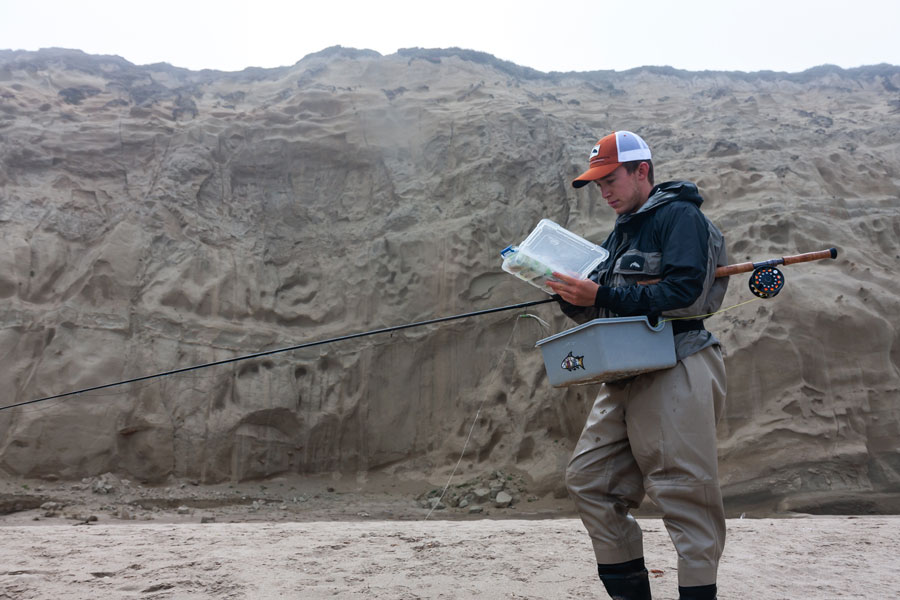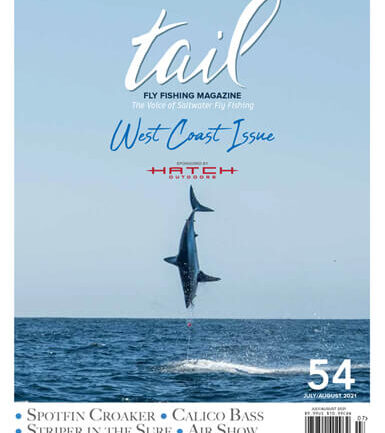Inshore Fishing, Stripers in the Suds
I open heavy eyes to the persistent sound of my iPhone alarm. The phone reads 2:30 a.m. What the hell am I doing? After all, I have stripers in my backyard on the California Delta; why am I driving two hours to go chase them? But as I come to, it all starts to make sense again. It’s August, and it’s going to be 104 degrees at home today. The beach is expecting a high of 58 degrees. The smell of the salt spray, the cool, damp fog, and most important, the chance to hook a big striper—I’m moving again.
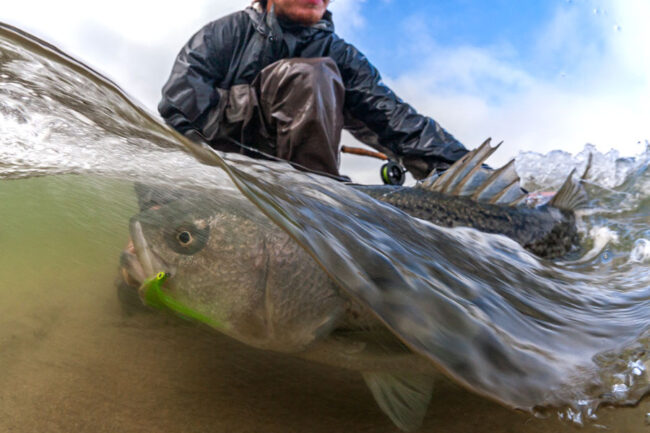 I’m headed to meet my buddy Loren Elliot, who has been consistently on the bite. I arrive at 5:15 a.m. on a turnout on the side of US Highway 101. It’s still pitch dark as we rig up our switch and two-handed rods, step into our boot-foot waders, and slide on our surf jackets. With headlamps we rappel down a steep bank with a rope that is moored to the mountainside. We arrive on the beach as daylight is breaking. The surf is small for Northern California—just 3 to 5 feet—but still much more formidable than the waters of Southern California. This area is home to Mavericks, one of the biggest surf breaks in the world. Here the Pacific Ocean still has some bite even in the more docile summer months.
I’m headed to meet my buddy Loren Elliot, who has been consistently on the bite. I arrive at 5:15 a.m. on a turnout on the side of US Highway 101. It’s still pitch dark as we rig up our switch and two-handed rods, step into our boot-foot waders, and slide on our surf jackets. With headlamps we rappel down a steep bank with a rope that is moored to the mountainside. We arrive on the beach as daylight is breaking. The surf is small for Northern California—just 3 to 5 feet—but still much more formidable than the waters of Southern California. This area is home to Mavericks, one of the biggest surf breaks in the world. Here the Pacific Ocean still has some bite even in the more docile summer months.
Surf Fly Fishing in California
California surf fishing hasn’t been a huge draw for me, mainly because its primary target, the barred surf perch, found up and down the state’s beaches, is basically a saltwater bluegill. Tossing around an 8-weight for a fish that rarely reaches two pounds doesn’t exactly pull me to the beach. Stripers in the surf, however, are different. These East Coast transplants can grow to more than 50 pounds, and hunting them in the California surf is similar in catch rate and challenge to steelhead, one of my favorite targets. You must earn every one of them. Factor in the salt water running through their gills, the violence of the surf zone, and the backing you often see when hooked up, and you have a world-class game.
Loren scans the beach looking for troughs and rips—likely areas for ambushing stripers. We hike our way down the beach and begin casting into holding water. Our plan for the morning incoming tide is sticking and moving, trying to locate a pod or school. The water is rising and changing by the minute, and a good trough that begins to appear at a creek mouth draws my attention. Loren bombs casts over the crashing waves, aided by the additional length of the two-hander, searching a hole that sits on the back side of the waves.
Striper Strip is all About Fly Line Management
Fly line management is one of the most challenging aspects of this game. Each wave has the potential to knock your fly line out of the stripping basket; with just one loop of line sliding out, within seconds your entire fly line is behind you on its way up the beach. The basket is a necessary evil: It influences your natural striper strip, but without it you are hosed because the churning waves would tangle your line after every cast.
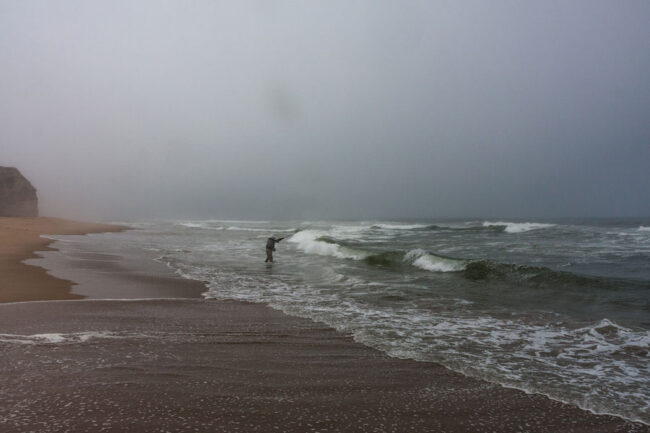
Watch for Forming Troughs to Hook Stripers in the Suds
I wade back to the beach, eyeing the newly forming trough running parallel to the dry sand; Loren wades deep, casting long into the Pacific. Now I’m wading in ankle-deep water and only casting 40 feet, effectively fishing the trough. The newly formed river of current sweeps right to left in front of me. Midway through my second cast as the fly is swinging across the current, my fly stops. I pull the trigger and set hard, knowing that my 20-pound test can absorb the swing. Within seconds the fish is gone, plowing its way through the churning surf. I watch approximately 40 feet of backing leave my reel. After about a 10-minute battle I begin shuffling up the beach, lurching the striper toward the bank. Loren arrives to help me land it. It’s a 10-pounder that pulled as hard as any striper that size ever has for me. Something about that ice-cold Pacific salt water, I think. We snap a few pictures, and the striper swims back into the surf. Now the pain of the 2:30 a.m. alarm is a distant memory.
About an hour later Loren’s deep wading pays off: He’s tight to a really good fish. This one is a different animal, staying much farther out and proving a much greater challenge to turn. After two deep runs and a 15-minute battle, we see the fish: He’s pushing 20 pounds—a true surf trophy. Loren carefully gauges each pressing wave and finally gets the big fish to slide in with one final wave surge. I lock my thumbs on the jaw of Loren’s best beach fish to date, and the fist pumps ensue.
As the tide tops off, we know our window has closed. It’s been an awesome session. From the early morning wake-up to the roar of the surf to the ever-changing water to the wave jumping, a Northern California surf session leaves us overstimulated. So we head to a local restaurant where we can grab some clam chowder and recap our good fortune.
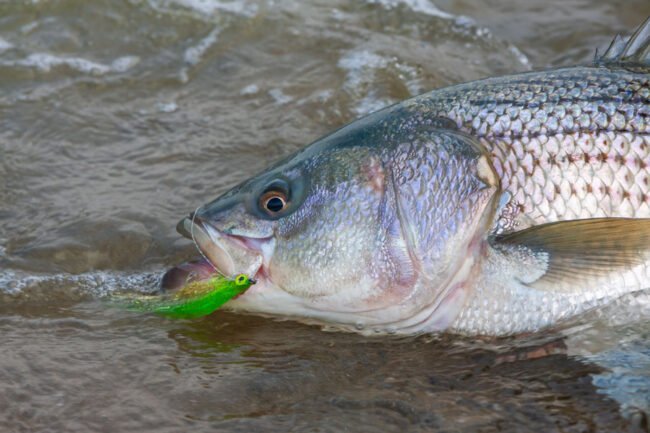 Despite the densely populated prime beach spots 50 miles north and south of the Golden Gate Bridge, California’s surf stripers get relatively light pressure compared to the more popular striper fisheries of the California Delta, San Luis Reservoir, and Sacramento River. Why? One reason is the sheer fury of the surf. This game isn’t easy and can be dangerous. So it’s always a good idea to fish with a buddy. George Revel, owner of San Francisco’s Lost Coast Outfitters, has even gone as far as wet wading in the surf—complete with guard socks and wool base layer bottoms and rain jacket—as a safety measure to avoid swimming with waders. Anglers can mitigate some of the danger by fishing inside the Golden Gate, where they’ll find more protected water. Note, however, that the opportunity to hook a big fish seems to diminish inside the Bay.
Despite the densely populated prime beach spots 50 miles north and south of the Golden Gate Bridge, California’s surf stripers get relatively light pressure compared to the more popular striper fisheries of the California Delta, San Luis Reservoir, and Sacramento River. Why? One reason is the sheer fury of the surf. This game isn’t easy and can be dangerous. So it’s always a good idea to fish with a buddy. George Revel, owner of San Francisco’s Lost Coast Outfitters, has even gone as far as wet wading in the surf—complete with guard socks and wool base layer bottoms and rain jacket—as a safety measure to avoid swimming with waders. Anglers can mitigate some of the danger by fishing inside the Golden Gate, where they’ll find more protected water. Note, however, that the opportunity to hook a big fish seems to diminish inside the Bay.
Lighter pressure might also result from the fact that fly angling for California surf stripers in the suds, isn’t a big numbers game, unlike the state’s other, more popular striper fisheries. The wind also plays a significant role, especially in the afternoons as the marine layer burns off. And it can be quite cold year-round on the beach, even in the preferred summer months. Finally, when it comes to reading the water and understanding the tides, this fishery has a steep learning curve. And yet not one of these hurdles is insurmountable. In the final analysis, this fishery is simply underrated.
John G. Sherman is the West Coast Sales Representative for Simms, St. Croix, Hatch, Waterworks-Lamson and Solitude Flies. He’s also a globetrotting angler, freelance photographer, and writer whose work can be found on Instagram: @johngsherman.
GET THE WEST COAST ISSUE 2021

